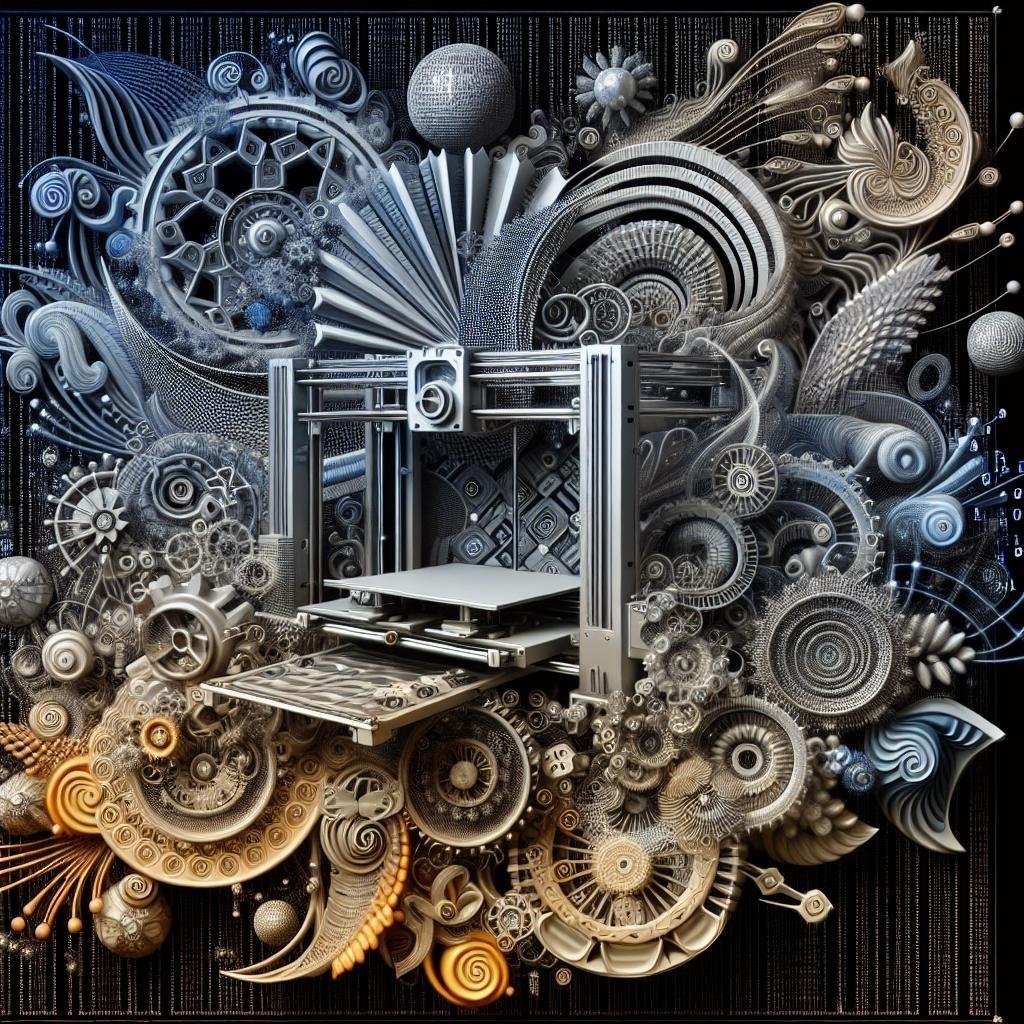Welcome to the future of manufacturing! Gone are the days when industrial 3D printing was a distant dream or an exclusive playground for a select few tech-savvy pioneers. Today, the world of industrial 3D printing has exploded into a thriving ecosystem brimming with innovation and endless possibilities. Whether you’re a seasoned engineer looking to prototype the next big breakthrough, a designer aiming to revolutionize traditional production methods, or a business leader wanting to cut costs and elevate efficiency, the right 3D printer can be your ultimate game-changer. So, fasten your seatbelts as we embark on a journey through the best 3D printers for industrial use. Together, we’ll explore cutting-edge technologies, powerful features, and real-world applications that are reshaping industries one layer at a time. Welcome aboard!
Understanding Industrial-Grade Precision
When diving into the realm of industrial-grade 3D printers, **precision** stands as a cardinal pillar. These advanced machines are designed to deliver incredibly fine details, ensuring every layer is crafted to perfection. Such precision is crucial for industries like aerospace, automotive, and medical fields where even the smallest discrepancy can result in significant setbacks. Industrial 3D printers employ sophisticated layers of technology including high-resolution sensors, enhanced calibration processes, and advanced software algorithms to guarantee that each print meets stringent standards.
Moreover, the versatility in **materials** used by these printers broadens the horizon of possibilities. Unlike consumer-grade printers limited to basic plastics, industrial-grade ones can work with a diverse range of materials such as **titanium alloys, carbon fiber-reinforced composites, and advanced ceramics**. This capability expands their utility, accommodating a myriad of applications from creating robust mechanical parts to intricate medical implants. The combination of precision and material diversity ensures unparalleled quality and reliability, making them indispensable in modern manufacturing landscapes.
| Material Type | Common Uses |
|---|---|
| **Titanium Alloys** | Aerospace components |
| **Carbon Fiber** | Automotive parts |
| **Advanced Ceramics** | Medical implants |

Top Materials and Compatibility for High-Performance Printing
When it comes to high-performance 3D printing in an industrial setting, selecting the right materials is paramount. **Materials** such as **PEEK** (Polyetheretherketone), **ULTEM** (Polyetherimide), and **CFRP** (Carbon Fiber Reinforced Polymer) stand out for their strength, durability, and resistance to extreme environmental conditions. These advanced materials ensure the creation of parts that possess exacting mechanical properties and can endure harsh industrial applications. **FDM** (Fused Deposition Modeling) 3D printers are particularly well-suited to handle these materials, offering consistency and precision that meet the demanding needs of industries like aerospace, automotive, and healthcare.
Compatibility between 3D printers and materials is key to achieving optimal results. Let’s look at a few examples:
| Material | Compatible Printers | Applications |
|---|---|---|
| **PEEK** | INTAMSYS, Apium P220 | Aerospace components, medical implants |
| **ULTEM** | Stratasys Fortus, CreatBot F430 | Automotive parts, industrial tools |
| **CFRP** | Markforged X7, Anisoprint Composer | Lightweight structures, robotic arms |
Combining **innovative materials** with **state-of-the-art printers** allows manufacturers to push the boundaries of what’s possible, creating stronger, lighter, and more reliable products that drive industry progress.

Speed vs. Detail: Finding the Right Balance for Your Business
When selecting the ideal 3D printer for industrial applications, it’s crucial to weigh **speed** against **detail** to ensure you match the right machine to your needs. A 3D printer that operates at lightning-fast speeds may be advantageous for rapid prototyping and mass production. However, if the finer details are compromised, the end product may not meet the high standards required for certain tasks. Conversely, a printer that emphasizes detail, producing intricate and precise outputs, might slow down your manufacturing timeline, which can be a drawback if speed to market is a critical factor for your operation.
Here are some key considerations to help find that sweet spot between speed and detail:
- Material Compatibility: Ensure the printer supports the materials essential for your products.
- Layer Resolution: Opt for a balance; higher resolution for greater detail, but determine if an ultra-fine resolution is truly necessary for all applications.
- Print Volume: Larger volumes can expedite batch production but might slow down individual prints.
| Model | Speed | Detail |
|---|---|---|
| SpeedMaster Pro | High | Medium |
| Detail Crafter 3000 | Medium | High |
| BalancedCraft X7 | Medium-High | Medium-High |
Don’t forget to consider **maintenance** and **operating costs**, as these can influence both the speed and the quality of your 3D printed products. Choose a machine that aligns with your business goals, and you’ll be on your way to seamless production success.

Trusted Brands Delivering On Industrial Promises
When it comes to 3D printing solutions for industrial applications, a handful of brands stand out for consistently delivering reliability and performance. **Stratasys**, **Ultimaker**, and **Markforged** are at the forefront, each offering unique advantages tailored for various industrial needs. Stratasys, for example, has built its reputation on producing high-precision parts with a wide range of material options. Ultimaker shines with its user-friendly interface and versatility, perfect for rapid prototyping, while Markforged impresses with its revolutionary use of composite materials, making it the go-to for creating incredibly strong and durable parts.
These brands understand that industrial environments demand more than just print quality; they require unwavering performance under strenuous conditions. Here’s a quick comparison to highlight the standout features you need to know:
| Brand | Standout Feature | Best Application |
|---|---|---|
| Stratasys | High Precision & Material Range | Detailed Prototypes |
| Ultimaker | User-Friendly Interface | Rapid Prototyping |
| Markforged | Composite Materials | Durable Production Parts |
With such trusted brands leading the charge, businesses can confidently integrate 3D printing into their industrial processes, ensuring they meet and exceed their production promises.
Q&A
Q&A: Best 3D Printers for Industrial Use
Discover the Ultimate Machines for Your Business
Q1: Why should I consider investing in a 3D printer for industrial use?
A1: Great question! Industrial 3D printers are revolutionizing the manufacturing landscape. They offer unmatched precision, speed, and versatility, enabling you to quickly prototype, produce end-use parts, and streamline your production processes. Investing in one can reduce costs, save time, and ultimately give your business a competitive edge.
Q2: What are the key features to look for in an industrial 3D printer?
A2: When shopping for an industrial 3D printer, consider these critical factors:
- Build Volume: Ensure the printer can handle the size of your projects.
- Material Compatibility: Look for a printer that supports a broad range of materials.
- Print Speed: Faster printers can significantly reduce production timelines.
- Resolution & Precision: High-resolution printers produce more detailed and accurate parts.
- Durability & Reliability: Industrial settings demand rugged machines that can perform consistently.
Q3: What materials can I use with industrial 3D printers?
A3: Industrial 3D printers offer incredible versatility when it comes to materials. They can print with plastics (like ABS, PLA, and nylon), metals (such as titanium and stainless steel), resins, and even composites. Your choice depends on your specific application, whether it’s prototyping, tooling, or manufacturing.
Q4: How do maintenance and operational costs compare to traditional manufacturing?
A4: While the initial investment might be higher, 3D printers can lead to significant cost savings in the long run. Fewer raw materials are wasted, setup times are reduced, and tooling costs often disappear. Regular maintenance is needed, but it’s typically less frequent and easier than for traditional machinery.
Q5: Can you recommend some top-notch 3D printers for industrial use?
A5: Absolutely! Here are a few industry favorites:
- Stratasys F900: Known for its large build volume and high material versatility, perfect for aerospace and automotive industries.
- Ultimaker S5 Pro Bundle: Offers dual extrusion and is great for engineering-grade materials, plus it’s user-friendly and reliable.
- Formlabs Form 3L: Excels in resin printing with incredible detail, ideal for high-precision projects and small to medium-sized parts.
These would be excellent starting points, but always consider your specific needs and budget.
Q6: Can 3D printers handle mass production, or are they just for prototyping?
A6: While 3D printing shines in prototyping, many industrial printers are robust enough for low-to-medium volume production runs. Advances in technology mean that certain printers can now produce thousands of parts, making them a viable option for mass production in certain contexts.
Q7: Is training or special skill required to operate these printers?
A7: Modern industrial 3D printers are designed to be user-friendly, but some level of training is beneficial to get the most out of them. Many manufacturers offer comprehensive training programs and customer support to help you get started and maintain your printer. Having a certified operator can also maximize efficiency and troubleshoot any issues that arise.
Q8: How quick is the return on investment (ROI) with an industrial 3D printer?
A8: The ROI depends on usage frequency and application. For many businesses, the savings on prototyping, reduced lead times, and decreased labor costs can lead to a swift payback period—sometimes within a year. Continuous usage and optimized production will hasten your ROI, making these printers a worthy investment.
Q9: How does 3D printing impact sustainability in manufacturing?
A9: 3D printing can significantly enhance sustainability efforts. It reduces waste by using only the necessary material for production, allows for the creation of lightweight parts that can lower transportation emissions, and often uses recyclable materials. In short, it’s a smart move for eco-conscious businesses.
Q10: Any last tips or advice for someone looking to buy their first industrial 3D printer?
A10: Definitely! Take the time to:
- Research: Understand the specific needs of your industry and applications.
- Test, If Possible: Some vendors offer demos or sample prints.
- Budget Wisely: Factor in not just the printer cost, but also materials, maintenance, and training.
- Plan for the Future: Choose a printer that can grow with your business and adapt to your needs.
Investing in an industrial 3D printer is a big step, but with thoughtful consideration, it can substantially elevate your manufacturing game!
There you have it! Ready to explore the transformative power of industrial 3D printing? Dive in, and let your imagination shape the future of your business. 🚀
Final Thoughts
As the gears of innovation spin ever forward, 3D printing stands tall as a titan in the industrial arena, transforming boundless possibilities into tangible realities. From the whirring matrix of the factory floor to the quiet hum of design studios, the majestic symphony of 3D printers orchestrates a new age of manufacturing excellence.
With the myriad of choices available, it’s essential to match your needs with the right tool, and our exploration through the best 3D printers for industrial use aims to illuminate your path. Whether you’re dreaming of sculpting intricate prototypes, streamlining production processes, or conjuring robust mechanical parts, the perfect machine lies within your grasp, ready to elevate your craftsmanship to unprecedented heights.
So, as you venture forth into this brave new world of additive manufacturing, may your print beds always be level, your filaments ever versatile, and your creativity utterly unfettered. Here’s to building the future, one breathtaking layer at a time! Happy printing!

